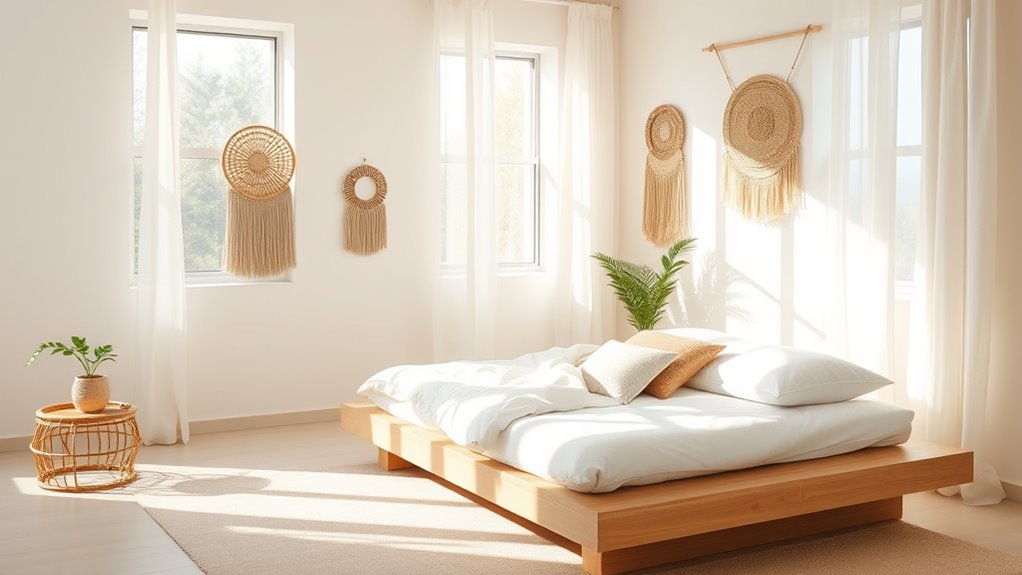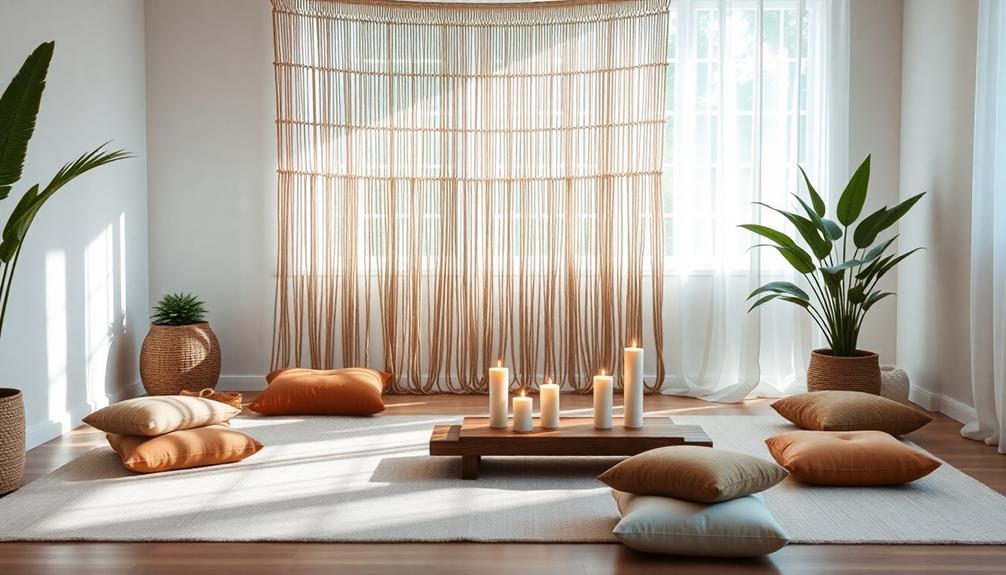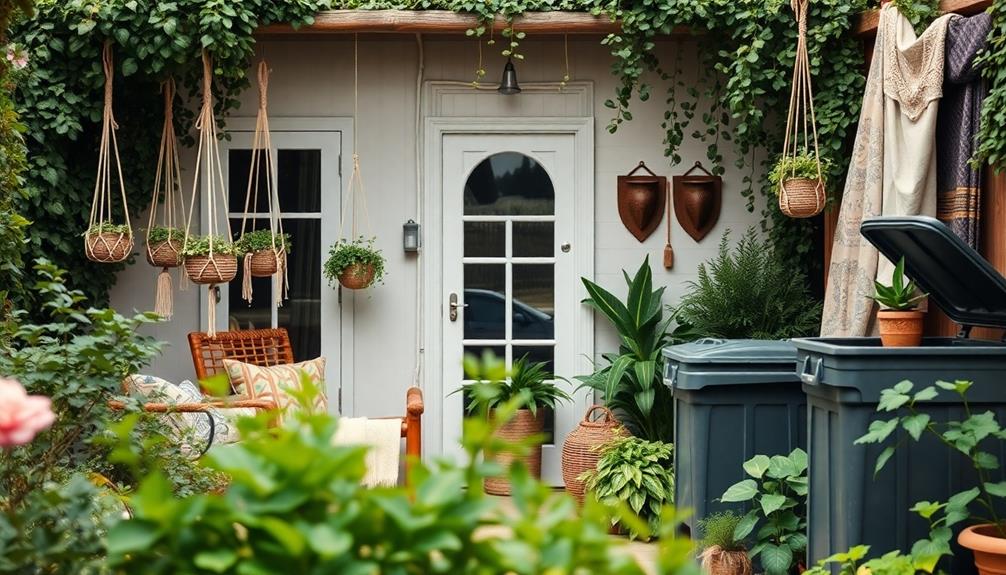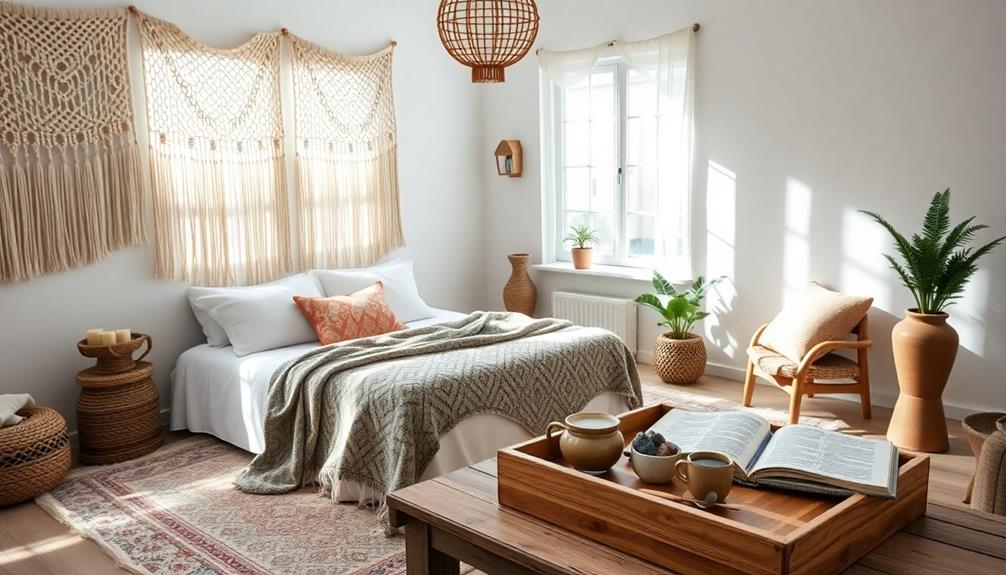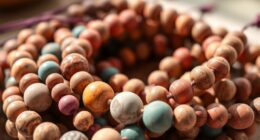Boho minimalism combines the relaxed, eclectic vibe of bohemian decor with the clean, uncluttered principles of minimalism. You’ll focus on neutral tones, natural materials like wood and rattan, and textured fabrics to create a calm, inviting space. By choosing meaningful décor and avoiding overcrowding, you foster a sense of serenity and personality. If you want to discover how to balance style with simplicity effortlessly, keep exploring these thoughtful design ideas.
Key Takeaways
- Emphasize neutral, earthy color palettes combined with vibrant textiles for a balanced, relaxed aesthetic.
- Select meaningful, functional décor pieces that add character without clutter.
- Incorporate natural materials like wood, rattan, and clay to enhance organic warmth.
- Maintain open, airy spaces through intentional decluttering and strategic placement of items.
- Curate a personalized environment by blending vintage, handcrafted, and minimal decor elements.

Boho minimalism blends the relaxed, eclectic charm of bohemian decor with the clean, uncluttered principles of minimalism to create a space that feels both inviting and serene. Imagine stepping into a minimalist bohemian living room where simplicity reigns, but personality still shines through.
Boho minimalism fuses relaxed charm with clean simplicity for an inviting, serene home environment.
This style emphasizes a neutral color palette, grounding the space with subtle earthy tones that evoke a sense of calm. Think of soft beiges, warm taupes, and gentle greys, complemented by vibrant boho textiles that add pops of color without overwhelming the senses.
In a boho minimalist space, every piece of curated décor is carefully chosen for its meaning and function. Instead of excess, you focus on a few impactful items—handmade art, vintage finds, or unique sculptures—that reflect your personality. These elements serve as focal points, creating a balance between aesthetic appeal and simplicity.
Textured fabrics like linen, woven textiles, and soft throws add depth and warmth, making the space feel cozy yet uncluttered. You avoid overcrowding by selecting items that contribute to the overall harmony, ensuring each piece has a purpose.
Natural materials play a crucial role in maintaining the organic warmth characteristic of boho minimalism. Incorporate wood, rattan, clay, and other earthy elements that bring a tactile dimension to your space. These materials, combined with a neutral color palette, foster a soothing environment that encourages relaxation.
Indoor plants further enhance this organic feel. Strategically placed greenery not only adds life but also purifies the air and connects your home to nature.
Decluttering remains a cornerstone of boho minimalism. You consciously limit the number of possessions, keeping only those that add value or beauty. This practice helps you maintain an airy, spacious atmosphere where everything has its place.
By removing unnecessary items, you create a calm environment that encourages mindfulness and peace. Each piece in your space is intentional, contributing to a cohesive, harmonious aesthetic.
In essence, boho minimalism isn’t about sacrificing personality for simplicity; it’s about balancing both. Through curated décor, textured fabrics, natural materials, and a neutral palette, you craft a space that’s inviting and serene.
Vintage finds and handcrafted art inject character, while decluttering ensures a clean, organized vibe. This style proves that less truly is more—creating a home that feels effortless, warm, and uniquely yours.
Frequently Asked Questions
What Does Less Is More Mean in Minimalism?
When you hear “less is more” in minimalism, it means you focus on simplifying your space by removing clutter and unnecessary items.
You choose quality over quantity, emphasizing clean lines and open areas to create a peaceful environment.
Each piece you keep serves a purpose, helping you feel more relaxed and clear-minded.
What Is the Difference Between Boho and Minimalism?
Imagine a vivid tapestry versus a simple canvas—that’s the difference between boho and minimalism. You’ll find boho bursting with vibrant colors, layered textiles, and eclectic decor, creating a cozy, relaxed vibe.
Minimalism, on the other hand, champions clean lines, neutral tones, and open spaces. You control the mood: lively and expressive or calm and streamlined.
Both styles reflect your personality, but they speak very different design languages.
Can Boho Be Minimalist?
Yes, you can make boho style minimalist by choosing only essential, curated decor pieces with natural materials and neutral tones. Focus on simplicity and intentionality, reducing clutter while keeping bohemian textures and organic elements.
Use meaningful items like handcrafted textiles and greenery, layering textures without overwhelming the space. This way, you balance vibrant accents with clean lines, creating a harmonious, uncluttered look that embodies both boho charm and minimalist elegance.
Is Boho Style Going Out?
You might think boho style is fading, but it’s actually evolving. Trends show a shift toward more minimalist, pared-down interpretations that emphasize natural textures and neutral colors.
Instead of disappearing, boho is blending with minimalism to stay fresh and relevant. So, rather than going out, boho is transforming into a versatile, modern look that suits today’s understated aesthetic, giving you a chance to create a relaxed yet stylish space.
Conclusion
As you embrace boho minimalism, imagine your space bathed in soft, natural light, where earthy tones and simple textures create a calming sanctuary. Each carefully chosen piece whispers tranquility, inviting you to breathe deeply and feel grounded. Less clutter, more serenity—your environment becomes a canvas of effortless elegance. In this pared-down harmony, you find freedom and inspiration, a quiet reminder that sometimes, less truly is more, transforming your home into a peaceful haven you cherish.

